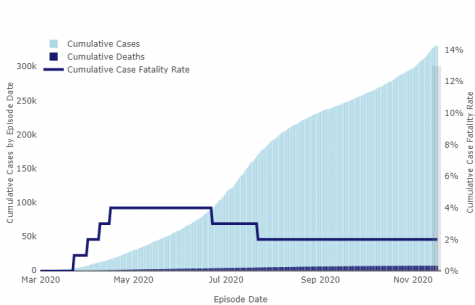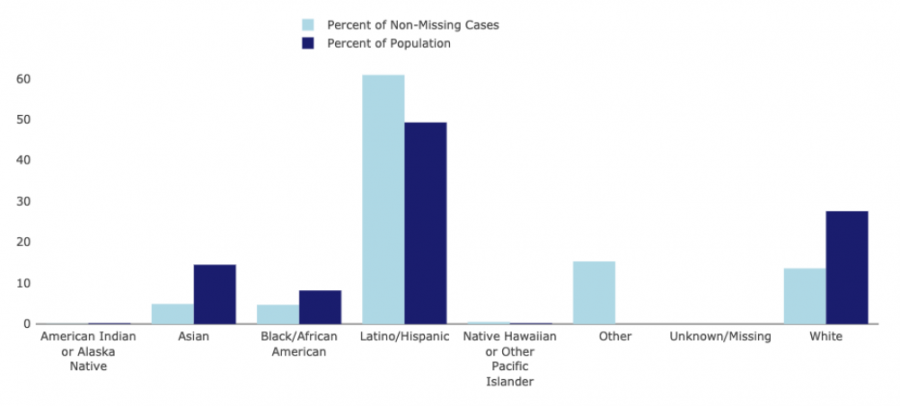COVID-19 Update: ‘Limited’ stay-at-home order begins on Saturday for L.A. County
November 19, 2020
Los Angeles County has the highest number of cumulative cases in the United States, while multiple other counties in California see a rise in the number of cases per capita.
The Centers for Disease Control and Prevention forecasts an upward trend in the number of deaths nationwide. L.A. County currently holds the record for the most confirmed cases in the nation.
We have compiled data and guidance from the Los Angeles County Department of Public Health to provide an update for L.A. County. Data is up to date as of Nov. 19. Here is your weekly COVID-19 update.
Total cases:

Since the first confirmed case of COVID-19 in L.A. County on Jan. 26, the number of positive cases continues to rise. Over 3% of L.A. County’s population of 10 million has had COVID-19.

CSUN cases:
As of Nov. 17, there have been 30 reported cases among students and 20 reported cases among employees.
There are no current cases that have been reported as a result of on-campus exposure.

These cases are reported to CSUN by individuals or public health officials. The university does not disclose the specific location of infected individuals for privacy reasons, but potentially exposed areas are disinfected prior to reopening.
If you test positive for COVID-19, whether or not you have been on campus, notify Yolanda Chassiakos, the CSUN Pandemic Manager, by emailing linda.reid.chassiakos@csun.edu.
Hospitalizations:
There are 1,298 COVID-19 positive patients currently hospitalized in L.A. County. There are 344 COVID-19 positive patients in the Intensive Care Unit. The County currently has 585 available ICU beds.
Race and ethnicity:
L.A. County’s data show that cases and deaths disproportionately affect people of color.
The L.A. County Department of Public Health reported that Latinos make up 60.9% of cases with data on race and ethnicity compared to the population, while whites account for 13.6% of cases compared to the population.
Latinos account for 51.8% of all COVID-19 deaths when compared to the population.
Local official updates:
California Department of Public Health issues Limited Stay at Home Order
The California Department of Public Health issued a temporary limited Stay at Home order on Thursday, meaning non-essential work and gatherings must stop from 10 p.m. to 5 a.m. for counties in the most restrictive purple tier.
The order will remain in effect for one month, starting on Saturday at 10 p.m. and ending on Dec. 21.
For counties who move into the purple tier after Nov. 21, the order will take effect at 10 p.m. on the second day following one full day in the purple tier.
Newsom “pulling the emergency brake”
Gov. Gavin Newsom announced during a press conference on Monday that 40 counties in California are moving back to more restrictive tiers in the Blueprint for a Safer Economy.
There were 13 counties were in the most-restrictive purple tier last week. However, there is a total of 41 counties are in the tier this week. Only 17 counties are in less restrictive tiers.
Counties that have reported higher case and hospitalization rates for two consecutive weeks were subject to moving back to a more restrictive tier. Now, the state will reassign tiers on any given day of the week to counties that show alarming data.
Multiple tier reassignments may also occur in a week if data related to case rate, positivity rate or hospital capacity indicates immediate intervention from the state.
Cases have doubled across California in the last 10 days, which is the fastest increase in cases the state has seen. Before this month, the highest daily case rate was between June 15 and June 21 at 39.2%. Between Nov. 1 and 7, the daily case rate was 51.3%.
Face coverings must be worn outdoors at all times
The state provided extended face covering guidelines on Monday. Through the updated guidelines, people must wear face coverings outdoors at all times if they are within 6 feet of someone outside of their household.
There are exceptions in particular settings, like when eating and drinking 6 feet away from someone outside of your household, when working alone in an office or room, or when in the car with members of your household.
Those exempted from having to wear a mask through the California Department of Public Health guidance do not have to wear a mask. If receiving a service that requires access to the nose or face, masks may temporarily be removed.
Travel advisory issued by the state
The California Department of Public Health issued a travel advisory on Nov. 13, to discourage out of state travel for non-essential reasons. People who travel or have guests from out of state should do a 14-day quarantine before meeting with people in the state.
Washington and Oregon have also issued similar travel advisories.
Highest case rate in L.A. is in Pacoima
Pacoima has the highest case rate of all the cities and communities in Los Angeles, according to the L.A. County Department of Public Health. Pacoima’s 14-day adjusted case rate is 578 cases per 100,000 people.
New county restrictions will be enforced on Friday
As cases and hospitalizations continue to increase, L.A County Department of Public Health is tightening restrictions starting on Friday. Restaurants, breweries, wineries, bars and non-essential retail must close from 10 p.m. to 6 a.m.
The outdoor capacity is limited to 50% at restaurants, breweries, wineries, cardrooms and outdoor family entertainment. Non-essential establishments that operate indoors are limited to 25% of the maximum occupancy.
Private outdoor gatherings are limited to 15 people, from no more than three households total.
Indoor and outdoor operations at bars, restaurants, breweries and wineries will be prohibited if the five-day average of cases reaches 4,000 or hospitalizations increase to 1,750 per day. At that point, only pick-up or delivery services will be allowed.
Additionally, if the five-day case average is 4,500 or hospitalizations increase to 2,000 per day, a three week Safer at Home order will be issued for the County. At that point, a 10 p.m. to 6 a.m. curfew would be enacted for non-essential workers and only essential workers would be allowed to leave their homes.
The Centers for Disease Control advises against Thanksgiving travel
The CDC issued recommendations for celebrating Thanksgiving this year, urging people to gather only with members of their household.
Before traveling, the CDC advises people to ask themselves critical questions about personal behaviors and to review case rates both in one’s hometown and destination.
A list of suggestions for alternate celebrations is also available on their website.
What’s open:
Grocery stores
Essential retail
Some non-essential retail with modifications
Parks and beaches with modifications
Golf courses
Hotels with modifications
Shared residential pools
Nail salons – limited to 25% capacity
Hair salons – limited to 25% capacity
Barber shops – limited to 25% capacity
Gyms (outdoors with modifications)
Indoor shopping malls – limited to 25% capacity
Breweries
Wineries
Cardrooms
Zoos (outdoors with modifications)
What’s closed:
Indoor dining at restaurants
Indoor houses of worship
Indoor gyms
Bars
Tattoo shops
Face masks are still required in public. Gatherings should be limited to only people in your household.
Testing:
The L.A. County website has a list of testing locations available for both walk-up and drive-up testing. Testing is available by appointment only.
A comprehensive map of testing locations can be found here. Hours of operation at city testing locations have been extended from 8 a.m. to 4 p.m. daily.
